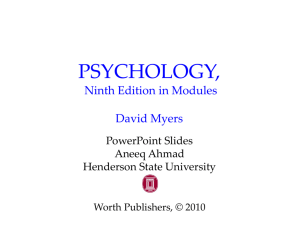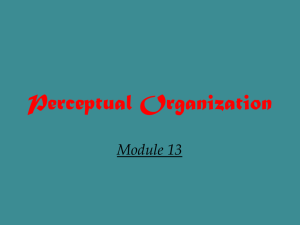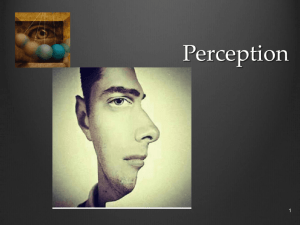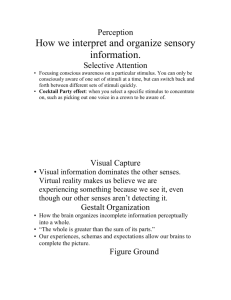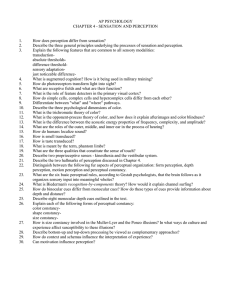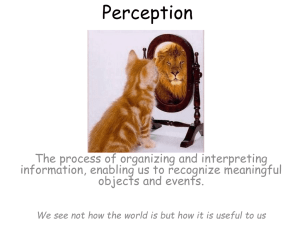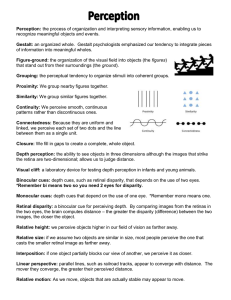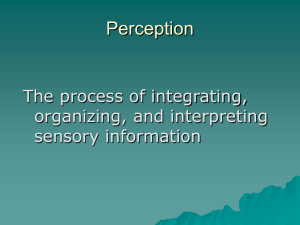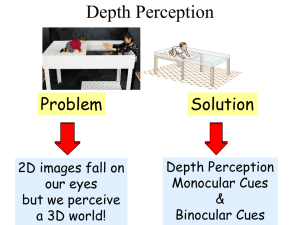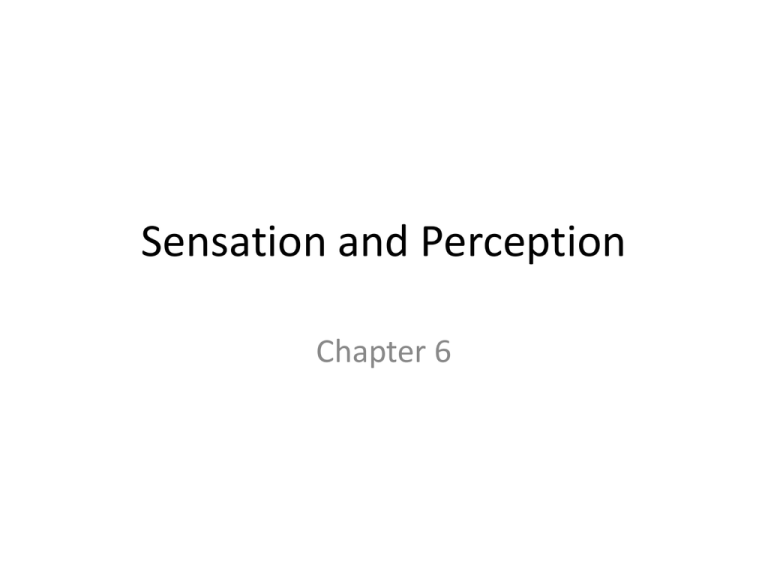
Sensation and Perception
Chapter 6
Sensation
The Eye
3
Photoreceptors
E.R. Lewis, Y.Y. Zeevi, F.S Werblin, 1969
4
Perception
Test your Blind Spot
Use your textbook. Close your left eye, and fixate
your right eye on the black dot. Move the page
towards your eye and away from your eye. At
some point the car on the right will disappear due
to a blind spot.
6
Bottom-up Processing
Analysis of the stimulus begins with the sense
receptors and works up to the level of the brain
and mind.
Letter “A” is really a black blotch broken down into
features by the brain that we perceive as an “A.”
7
Feature Detection
Ross Kinnaird/ Allsport/ Getty Images
Nerve cells in the visual cortex respond to
specific features, such as edges, angles, and
movement.
8
Visual Information Processing
parallel processing The brain divides a visual
scene into subdivisions such as color, depth, form,
movement, etc.
9
Top-Down Processing
Information processing guided by higher-level
mental processes as we construct perceptions,
drawing on our experience and expectations.
THE CHT
10
Thresholds
Proportion of “Yes” Responses
1.00
0.50
0.00
Absolute Threshold: Minimum stimulation needed
to detect a particular stimulus 50% of the time.
0
5
10
15
20
Stimulus Intensity (lumens)
25
11
Subconscious Sense and Perception
Subliminal Threshold:
Priming
Length of effects
12
Adaptation/Habituation
• Stare at the image, don’t move your eyes around
Perceptual Organization
15
Flipped image
Figure/Ground
Time Savings Suggestion, © 2003 Roger Sheperd.
17
Grouping
18
Innervisions
Depth Perception
Visual Cliff
19
Binocular Cues
Retinal disparity: Images from the two eyes differ. Try
looking at your two index fingers when pointing them
towards each other half an inch apart and about 5 inches
directly in front of your eyes. You will see a “finger
sausage” as shown in the inset.
20
Monocular Cues
Relative Size: If two objects are similar in size, we
perceive the one that casts a smaller retinal image
to be farther away.
21
Monocular Cues
Interposition: Objects that occlude (block) other
objects tend to be perceived as closer.
Rene Magritte, The Blank Signature, oil on canvas,
National Gallery of Art, Washington. Collection of
Mr. and Mrs. Paul Mellon. Photo by Richard Carafelli.
22
Monocular Cues
Relative motion:
23
Monocular Cues
Linear Perspective: Parallel lines, such as railroad
tracks, appear to converge in the distance. The
more the lines converge, the greater their
perceived distance.
© The New Yorker Collection, 2002, Jack Ziegler
from cartoonbank.com. All rights reserved.
24
Monocular Cues
Light and Shadow: Nearby objects reflect more light into
our eyes than more distant objects. Given two identical
objects, the dimmer one appears to be farther away.
From “Perceiving Shape From Shading” by Vilayaur
S. Ramachandran. © 1988 by Scientific American, Inc.
All rights reserved.
25
Perceptual Constancy
Perceiving objects as unchanging even as
illumination and retinal images change.
26
Color Constancy
Color Constancy
27
Lightness Constancy
The color and brightness of square A and B are the same.
28
Size-Distance Relationship
Alan Choisnet/ The Image Bank
From Shepard, 1990
29
Size-Distance Relationship
Both girls in the room are of similar height.
However, we perceive them to be of different
heights as they stand in the two corners of the
room.
Both photos from S. Schwartzenberg/ The Exploratorium
30
Ames Room
The Ames room is designed to demonstrate the sizedistance illusion.
31
Perceptual Interpretation
How important is experience in shaping our
perceptual interpretation?
32
Facial Recognition
Courtesy of Richard LeGrand
After blind adults
regained sight, they were
able to recognize distinct
features, but were unable
to recognize faces.
Normal observers also
show difficulty in facial
recognition when the
lower half of the pictures
are changed.
33
Sensory Deprivation
Kittens raised
without exposure to
horizontal lines later
had difficulty
perceiving horizontal
bars.
Blakemore & Cooper (1970)
34
Top down emotional effects
•
•
•
•
Music
Fatigue
Carrying heavy versus light objects
Previous performance
Cultural Context
Context instilled by culture also alters
perception.
To an East African, the woman sitting is balancing a metal
box on her head, while the family is sitting under a tree.
36
Taste
Sweet
Sour
Salty
Bitter
Umami
(Fresh
Chicken)
37
Gustation/Tast
e – a close-up
view of the
tongue
Why does some food taste
“hot”?
• Hot chili peppers are sensed
by pain fibers in the tongue,
which are activated by
capsaicin
• Was evolved in the peppers
to prevent them from being
eaten
Smell
40
What is your favorite scent?
Smell and Memories
42


